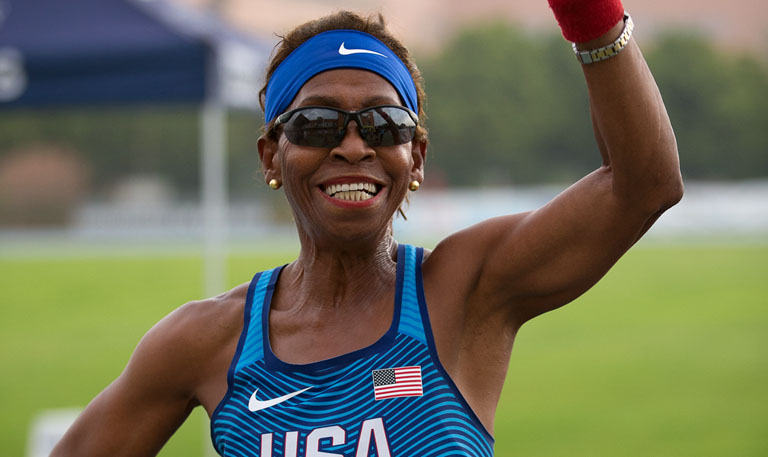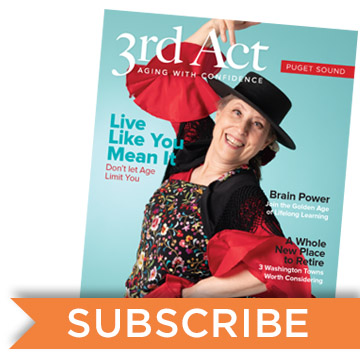I take photos of active seniors. In fact, I take photos of very active seniors—elite athletes in their 60s, 70s, 80s, 90s, and, yes, 100s who compete at championship national and international events. I’ve been doing this for 15 years now, after despairing at the lack of positive imagery of older people in the media. When I did an Internet search for “images of older sportsmen and women,” all that came up was image after depressing image of older men and women slumped in their chairs. They lacked agency, they lacked movement (“sport” didn’t feature at all), they lacked community, and they certainly lacked joy.
Who’d want to get old if this was what lay ahead? And yet as a tennis playing, 60-year-old with plenty of older buddies running round the tennis court and competing for their club or indeed their country, I knew the moribund images I was seeing were only a small part of the aging story. I bought myself a camera, found a photography tutor and set out to document the good news—the sportsmen and women who show what the aging body is capable of (a lot!) and who compete at the highest level in the sport they love.
Bad news however makes a better story than good news. Not only was there little visual evidence of these older athletes in the media but few people—on my side of the pond at least—had any idea that such championship competitions existed. When I started showing my pictures in exhibitions or presentations and talking about the people I’d photographed, I was met with incredulity. Where were these events being held? Why weren’t they publicized more? How could you go and see them and even take part in them yourself? “Why don’t we know about them?” I kept getting asked. Yet everyone had gloomy stories to tell about older folk in decline, needing care, to the detriment of both family and nation. “Burden” was a word you heard all the time. There was one trajectory ahead for us as we get older, it seemed, and it was an incontrovertibly negative one.
So, by contrast, I immersed myself in the world of good news, focusing on sport-related things older people can do. The achievements of the elite athletes I discovered is jaw dropping: I’ve seen women in their 80s run 100m in just over 16 seconds and men age 80+ run it in just over 14 (for context, the Olympic world record for 100m is 10.61seconds for women and 9.62 for men). They’re fast. Trust me, when you’re standing at the finish line with your camera, and the gun goes off for the start, blink and it will be over. You have to get snapping fast, too.
To start with, I thought I’d be focusing—literally and figuratively—on the physical achievements of these remarkable men and women. Like their Olympian younger counterparts, they are indeed remarkable. Being an elite anything makes you an outlier. But then I realised that there was a quality at all the events I went to that overshone the extraordinary speeds they ran, the heights and lengths they jumped, the distances they threw. This quality was joy.
The events were brimming with joy, overflowing with joy. True, they were also brimming with the blood, sweat, and tears it takes to make and break world records, whatever our age, but the joy was palpable. It was joy that went way beyond the joy of achievement, of pushing your body to its limits and winning medals—though that was there, too. I kept trying to put my finger on it. I wanted to bottle it! Was it camaraderie? Yes, that too, but it was something more even than that. I decided it was the joy of community.
The American poet and writer Enuma Okuro writes about the value of “creating communities that feel safe enough for us to show up in our complicated selves, and that keep us open to giving, receiving and being transformed.” The more I’ve embedded myself in the world of older sportsmen and women— be they track & field athletes, hockey players, cyclists, swimmers or whatever—the more I realise that this is absolutely what they do. They create safe and nurturing communities of very different people with one key common interest—their chosen sport. Each individual has a story, each one has his or her own path to being there. Even calling them “elite athletes” implies a homogeneity that simply isn’t there. It’s a messier, more complicated, and more interesting picture than that.
I used to think that these athletes I was photographing were super-human, the lucky ones who could effortlessly run, swim or cycle faster, or play their sport with a higher degree of skill and dexterity, than the rest of us lesser mortals. But they’re not. They put in the hours of training, they dedicate themselves week in, week out, to reaching their goals in the sport they love. But it’s tough and it hurts and it takes mental as well as physical fortitude and resilience to show up time after time. Because they all appreciate that every one of them is doing this, when they meet up at competitions, there’s a respect and a mutual understanding that glues them together.
They are, of course, susceptible to the same losses that hit the rest of us as we age— the cancers, the heart diseases, strokes, joint issues, and bereavements. I say “of course” but I ruefully have to admit I was disappointed to have the super-human fantasy bubble I’d built around them burst. They understand that there’s no escape from “the crap life throws at us,” as one athlete put it to me, even if it’s alongside medals, triumphs, and records. So, they support each other, across national boundaries, language barriers, and different age groups. They’re there for each other. They turn up on each other’s Facebook posts and on each other’s doorsteps. After 15 years alongside them, I’m only beginning to discover the extent to which they keep each other going, hold each other up.
I recently collaborated with filmmaker Danielle Sellwood to make a film that followed four British female masters athletes, ages 69 and 84, called Younger: Looking Forward to Getting Older. It was this very precious and real lived experience of community that shone through above all else for us. What keeps these women coming back time and again to gruelling competitions, often in terrible weather and in unglamorous, empty stadia? Simple.
“We do it for the people,” said one of them. Dorothy, our eldest participant at 84, has her tight-knit “gang”, a small group of fellow athletes who live in different parts of the UK but who phone each other daily, travel together to all the major events, and who show up at each other’s houses whenever illness or injury strike. As, increasingly it does.
One of the reasons I photograph older athletes is you can visually show how nuanced getting older is. It’s not all bad, just as being young isn’t all good. Both categories, if they even are ones, deserve more interesting scrutiny than flattening them out to reductive and simplistic clichés. Photos can reveal both wrinkles and muscles in the athletes’ arms and legs, with their implications of co-existent frailty and strength. Yes, aging brings its challenges, we’d be foolish to deny this, but it also can be a time of opportunity, of growth and yes, of transformation. And the same can be said of being young. What do all of us need? Each other, that’s what.
Call me a slow learner, but I’m only just appreciating—through the community I photograph—that when mishaps befall us, how we get through to the other side is by allowing ourselves to reach out to the hands that will guide us there. During these 15 years, I’ve had a hip replacement myself. My default setting is to catastrophise, which meant that, facing surgery, I was moaning about my fate to an athlete at an event. “Go and talk with Lucy,” she urged, indicating a woman in her 60s leaping over hurdles at that moment. “She’s had both hips done within two years of each other, the last one 18 months ago. Look at her now!” I did talk with Lucy, who promptly offered to mentor me through to the other side of my surgery and rehab. Through her and her fellow athletes I’m learning to reframe my catastrophising mentality. Old me: There’s a mountain blocking my path. New me (well, almost): There’s a mountain I can find a way across.
I also used to think the way to deal with the tough periods was to batten down the hatches and go it alone. Now I believe the opposite to be true. I’ve learned that together is how we make it through the night. I thought I had a mission to help transform some of the lazy stereotypes that exist in our society around aging but what’s happened is that the people I’ve been photographing have ended up transforming me. They’ve welcomed me into their community, and we’ve aged together, “my” athletes and me, not that we’re done yet. It’s a lifelong process, aging, and I’m deeply grateful to have them alongside me for the ride.
Alex Rotas is an award-winning photographer, writer, and speaker based in Bristol, England. She is known for her images of athletes aged 60+ that dramatically challenge negative perceptions of aging. She has exhibited globally in public spaces, health care settings, and galleries and contributed to numerous media discussions on aging and sport.
Alex’s film, Younger: Looking Forward to Getting Older, was released in cinemas across the UK in 2024. Made with British filmmaker Danielle Sellwood of Find It Film https://www.finditfilm.com, this 56-minute documentary follows four female British athletes aged between 69 and 84. “It gifts its viewers, of any age, an entirely new picture of what aging looks like,” writes Forbes magazine and “it is just so joyful… A powerful antidote to what the ageing process is supposed to look like,” according to BBC Radio Scotland. It will be available for rental on Prime in the U.S, and the UK in early 2025.


